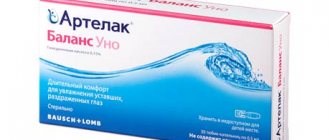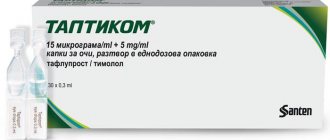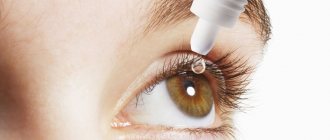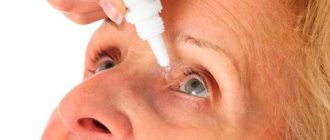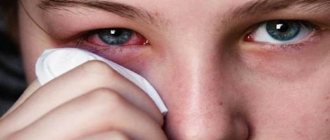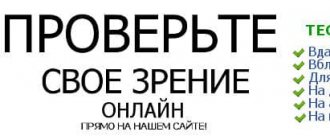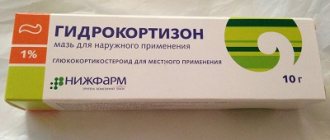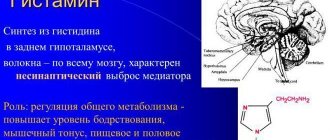Cataract is an age-related disease in which the structure of the lens is disrupted, it becomes cloudy and loses its ability to transmit light, which leads to blindness. Treatment without surgery is provided by eye drops for cataracts, which prevent the development of pathology.
Restoring vision is only possible through surgery; drops to improve vision are effective only at the initial stage of the disease and as a preventive measure.
What are the types of eye drops for cataracts?
Drug treatment of cataracts involves the constant or systematic use of drugs (drops) prescribed by the doctor for treatment. From the moment you are diagnosed by an ophthalmologist, cataracts become your permanent, chronic disease, which progresses all the time.
Eye drops for cataracts can slow down the progression of the disease, prevent complications, reduce discomfort and fatigue, but do not restore vision or completely cure it. You must understand this clearly, the operation is inevitable in any case, it is a matter of time.
Early diagnosis and timely detection of symptoms of the disease at the initial stage are very important. A drug such as Quinax helps against cataracts, delaying the time of surgery as much as possible.
All cataract drops are divided into three groups:
- To treat the disease, they are used on an ongoing basis from the moment of prescription; they must be dripped several times a day.
- For the prevention of cataracts - periodically instilled into healthy eyes to prevent any eye diseases as a general tonic.
- After lens replacement surgery, this is a specific therapy that includes a list of drugs with antibacterial, anti-inflammatory, and anti-edematous effects that help improve metabolic processes in the eyeball and enhance tissue regeneration.
It is important to know how to properly apply eye drops to patients with cataracts; half the effectiveness of treatment depends on this.
Stages of using eye drops, memo:
Basic Rules:
- Read the name of the drug, indications and side effects again;
- wash your hands thoroughly before the procedure;
- Preheat the bottle with the solution to body temperature;
- do not touch the eyeball with the tip of the pipette;
- instill the medicine behind the lower eyelid, while pressing the corner of the eye near the nose, since in this place the eye connects to the nasal cavity and the entire medicine can leak out;
- remove contact lenses during the procedure and put them back no earlier than after 15 minutes;
- use any medications with caution in the elderly;
- store the medicine out of reach of children, at a temperature of 7 to 25 degrees;
- an opened bottle is good for no more than one month.
Classification
Eye drops for glaucoma are created based on evidence of their effectiveness, which was obtained through large-scale trials that spanned the entire planet.
In recent decades, studies have been carried out in world practice to study:
- Glaucoma with normal pressure readings.
- Advanced glaucoma.
- Initial glaucoma.
- Ocular hypertension.
In the course of all this work, it was revealed that the requirements for the optimal drug for reducing ophthalmotonus are:
- Significant decrease in intraocular pressure (up to 30%).
- Preservation of the hypotensive effect over a long period of time (about 24 hours).
- Maintaining the minimum required level of IOP with minor fluctuations in its indicators throughout the day (maximum 5 mm Hg).
- Minimal risk of extraneous, unwanted reactions.
- Simple and clear dosage regimen.
Eye drops for glaucoma are divided into three large groups:
- Products that optimize the drainage of intraocular fluid (IOH). This occurs due to the improvement of the flow of intraocular fluid along the uveoscleral pathway. Such drugs have the most pronounced hypotensive effect.
- Agents that suppress the generation of intrauterine fluid. This happens due to the blocking of b-adrenergic receptors of the ciliary body.
- Combined drugs.
In turn, the first pharmacological products will be divided into three subgroups:
- Cholinomimetic agents.
- Adrenergic and sympathomimetics.
- Prostaglandins.
The second group of drugs is divided into:
- Antienzymes.
- Antiadrenergic drugs.
- Adrenergic and sympathomimetics.
Drops for the treatment of cataracts
Any medicine, including drops for the treatment of cataracts, no matter how wonderful and advertised they may be, should be prescribed to you by an ophthalmologist. Since only a doctor knows your stage and extent of the disease, the cause of the disorder in the protein structure of the lens and what exactly will help in your individual case.
The most effective and popular drops in the popular rating, used in the treatment of cataracts, are presented in the list below:
- "Quinax" - average cost 275-300 rubles;
- "Visomitin" - average cost 450-570 rubles;
- “Taurine” - average cost 15-370 rubles;
- “Katalin” - average cost 390-610 rubles;
- "Oftan Katahrom" - average cost 210-380 rubles;
- “Taufon” - average cost 90-230 rubles;
- “Vita-Yodurol” - average cost 280-460 rubles;
- "Khrustalin" - average cost 650-700 rubles.
To better understand drops for cataracts, to understand which ones are better and why, let’s take a closer look at each drug separately.
"Quinax"
A very good drug for the initial stage of cataracts, drops in the eyes can significantly slow down its development. The main active ingredient is azapentacene, 150 mcg/ml, promotes the resorption of opaque protein flakes deposited on the walls of the lens, and also activates the production of natural enzymes in the aqueous fluid of the eye.
Available in 15 ml plastic bottles, 2 drops instilled 3-5 times a day, sold by prescription. The result is long-term treatment with an accumulating effect; no side effects were observed; a contraindication may be an individual allergy or intolerance to the components of the drug, which causes an allergic reaction.
"Visomitin"
This medicine is used to eliminate a complication of cataracts such as dry eye syndrome. It has an antioxidant effect, stimulates tear production and epithelization (regeneration) of eye tissue. Contraindications are age under 18 years and hypersensitivity to the composition of the drug.
Available in the form of a plastic bottle of 5 ml. Apply 2 drops three times a day, duration of administration depends on the severity of symptoms. You can buy the medicine only with a prescription, the shelf life is 1 year, stored at a temperature of 3-9 degrees in its original packaging.
"Katalin"
The main active ingredient, pyrenoxine, helps to increase the penetrating ability of the lens membrane, which increases metabolic processes, eliminating stagnation and aging (turbidity) of the protein. The drug is indicated for age-related cataracts, as well as for cataracts as a complication of diabetes mellitus.
Sold by prescription in the form of tablets (75 mg) and solvent, the total amount of the drug after preparing the solution is 15 ml. 1-2 drops are instilled 5-6 times a day for several months. Side effects: redness, itching, burning in the eyes.
"Taufon"
Analog – “Taurine”. The main active ingredient is the amino acid taurine, 40 mg/ml, improves metabolism, energy metabolism, cell and tissue regeneration, is produced in the body independently, but with age in insufficient quantities. Successfully used in the treatment of glaucoma.
Available in dropper tubes of 1.5/2/5/10 ml, the regimen and dosage are prescribed individually by an ophthalmologist, the contraindication is individual intolerance to the components of the drug, it is available without a prescription.
"Taurine"
Analog – “Taufon”. The base is also an amino acid containing taurine sulfur, available in the form of a 4% solution of 5 ml. Helps improve the conductivity of nerve impulses; in fact, this is another trade name for Taufon, so we will not dwell on this drug in detail.
"Oftan Katahrom"
Manufacturer: Finland, quite a well-advertised product with good reviews. It contains three main substances:
- adenosine (2 mg/ml) - anti-inflammatory agent;
- nicotinamide (20 mg/ml) – nicotinic acid;
- cytochrome C (0.675 mg/ml) – antioxidant.
This is a complex drug that improves the metabolism of eye tissue and the lens. Available in 10 ml bottles. Prescribed 1-2 drops 3 times a day. Accompanied by conjunctivitis, burning, itching in the eyes. It is not prescribed for children and those with a history of allergies.
Oftan Katahrom is known for having proven clinical effectiveness against cataracts. It has a combined composition and contains a vitamin, antioxidant and energy source. This means that the drug definitely works. Also, ophthalmologists often prescribe it as part of complex therapy, since the drops combine well with other ophthalmic drugs.
"Vita-Yodurol"
Drops for the treatment and prevention of age-related, traumatic, congenital and secondary forms of cataracts. The drug increases blood supply to the lens by improving metabolic processes, promotes denaturation of the protein in the lens, and slows down the process of clouding.
Available in 10 ml plastic bottles with a pipette. Prescribed locally, 2-3 drops three times a day. Side effects may include allergies to the components of the drug. Opened packaging is stored for one month at a temperature of 13-22 degrees. When prescribed with other drugs, a pause of 10-20 minutes should be allowed between instillations.
"Khrustalin"
A combined multicomponent drug that helps prevent and treat structural changes in the tissues of the eyeball and lens. The drops have an analgesic, anti-inflammatory, and antibacterial effect. Relieves fatigue, hypertension and eye irritation.
The composition is very similar to Oftan Katahrom, but is very more expensive. Main active ingredients:
- sodium succinate;
- adenosine;
- benzalkonium chloride;
- nicotinamide;
- cytochrome C.
Available in 5 ml bottles. Prescribed one drop three times a day for a course of three months. Shelf life is three years.
Laser correction
This is a fairly well-developed look. therefore it is very popular. Here the operation is carried out using the excimer laser method, in most cases it is successful, and the person regains lost vision without any damage to health. There are several indications for using this method:
- If there is clouding of the lens.
- Retinal detachment on the face.
- The structure of the vitreous body has changed.
- The retinal vessels show signs of damage, most often associated with diabetes.
Laser vision correction
After the treatment is completed, the patient is under the supervision of doctors for another couple of hours, this is necessary for a control eye examination. The surgeon must ensure that the upper layers of the cornea are properly reattached. Touching your eyes during this time is strictly prohibited. The subsequent period also requires certain patient behavior:
- After going home, you should remember to make regular visits to the clinic as prescribed by your doctor. This is done to control the healing process.
- The doctor prescribes a special solution to be instilled into the eyes according to a scheme that must not be violated under any circumstances. The duration and frequency of instillation should also be strictly controlled; usually procedures are carried out at home two to three times a day. Drops are sold in pharmacies with a doctor's prescription.
- Medications may be used to calm or relieve pain after surgery.
- It is not recommended to sleep on your side or stomach on the first day after the intervention, only on your back.
- After laser correction, it is strictly forbidden to use shampoos, soaps, or any irritants. This period should be maintained for 3-4 days.
- Smoking is excluded for a week. Alcohol for a longer period.
- Also, for seven days you should avoid: swimming pools, saunas, swimming in any bodies of water, visiting beaches and solariums.
- Extreme sports and intense physical activity are prohibited.
- It is necessary to wear sunglasses and remain calm.
To speed up the rehabilitation period, many clinics offer an adaptation course using a device specially created for this purpose. It is based on computer training using video manipulations. These trainings allow you to speed up your recovery and should not be abandoned.
If the recommendations are followed, the patient can quickly restore visual function and feel relief.
Drops for the prevention of cataracts
Drops for the prevention of cataracts are used if you are predisposed to the disease, for example, if your parents had this pathology, if there are influences of harmful factors that can trigger the development of this disease, and in the initial stages of cataract development.
Drops are not the only panacea, but should be used in a complex of conservative preventive measures, including proper nutrition, vitamins and microelements for the eyes, maintaining a visual regime, wearing sunglasses, and regular visits to an ophthalmologist.
One of the prevention options is Catarax drops - these are red eye drops, the active ingredient is azapentacene. The drug makes it difficult to form a reaction between the protein structures of the lens and enzymes, leading to their denaturation.
The medicine is produced in plastic bottles of 15 ml, one bottle in a cardboard box, a pipette and instructions for “Catarax”. Prescribed 2-3 drops five times a day; check the course of treatment with your doctor. Complications include a local allergic reaction, itching and irritation of the conjunctiva. Sold by prescription, stored for three years in original packaging and a month when opened, at a temperature of 12-23 degrees.
Another drop that has successfully proven itself in the prevention of eye diseases is Vitafacol. Multi-component complex with vitamins and nutrients for the eyes. Restores damaged areas of cells, stimulates tissues to renewal and regeneration, controls metabolic processes in the lens to prevent stagnation and clouding in the form of loss of protein flakes.
Available in 12 ml bottles. Vitafacol is instilled twice a day. Shelf life is two years. There are no adverse reactions, there may be local irritation.
Stages of the disease
There are four stages of cataracts. The initial degree is characterized by slight clouding of the lens. Patients note the appearance of so-called visual acuity decreases. In the immature stage, the clouding increases and the lens becomes gray or whitish in color. Its fibers swell, and because of this, the volume increases. Visual acuity continues to decline (but slowly). Mature cataracts are characterized by deepening of the anterior chamber and no luminescence of the lens. A gray veil spreads over its surface. As a rule, in this case there is a loss of objective vision. The overripe degree has the following signs: due to loss of moisture, the lens shrinks and wrinkles, plaques appear on the organs of vision. It is worth noting that the development of the disease occurs over a fairly long period: 5-10 years. The cataract clinic is such that the longer a visit to the doctor is delayed, the greater the likelihood of losing vision.
The use of drops in the postoperative period
Surgery is the main method of treating cataracts. If the drops do not bring the expected result or you do not agree to instill them a hundred times a day, lens replacement surgery will solve all your problems. But keep in mind that drops are still used for some time after the operation.
The difference between eye drops after surgery and drops used to treat cataracts is their symptomatic, specific action. Surgery is a violation of tissue integrity, possible infection and a foreign body in the eye. Medicines are aimed at combating all these causes. It contains antibiotics, metabolics and antihistamines.
The most commonly prescribed drops after surgery:
- "Vitabact";
- "Maxitrol";
- "Naklof";
- "Tobradex";
- "Diklof."
Choosing drops for cataracts
Eye drops for any eye disease, including cataracts of one or both eyes, should be prescribed by an ophthalmologist. The disease itself occurs due to a decrease in the body’s ability to produce all the necessary enzymes and other biologically active substances at the proper level. And the drops either stimulate production or bring these substances from outside in their composition.
And what exactly you need and in what quantity, all indications and contraindications can be found out after an examination with a doctor, so do not self-medicate, do not do yourself a disservice.
What are the symptoms of cataracts?
To diagnose the disease in time, it is important to pay attention to the following symptoms. First of all, a person begins to see only blurry contours and outlines of objects. It becomes difficult to read and distinguish faces. Vision becomes especially poor in dark rooms and at night. Secondary cataracts can also manifest as increased sensitivity to light; flashes and glare appear in the eyes. Congenital cataracts are manifested by changes and clouding of the pupil in children, and strabismus. If a child does not respond to bright toys (silent ones), then this is a reason to urgently contact a specialist.
Other drugs in the treatment of cataracts
The cure for cataracts is not limited to purely drops; ordinary vitamins for cataracts, taken orally, are in no way inferior to local instillation. If you experience discomfort during instillation, most medications can be replaced with eye tablets.
An example of tablet forms of drugs for cataracts:
- "Giaral" - immunoglobulin;
- “Anthocyanin forte” – herbal dietary supplement;
- “Alfit” is a herbal medicine for restoring vision based on Altai herbs;
- “Cysteine” – normalizes metabolic processes in the lens of the eye.
There are also injections and ointments, the use of which is indicated under the supervision of a doctor. Do not self-medicate, it can harm your health.
If you have used any product to treat cataracts, please leave your review in the comments. Share the article with your friends. All the best! Eye drops for allergies, read the link.
Information about pathologies
Diseases differ greatly from each other in their origin and manifestation.
Glaucoma: causes, symptoms
The main cause of pathological changes is a disruption in the process of inflow and outflow of fluid in the eye, which leads to an increase in intraocular pressure. Under the influence of high load and insufficient blood circulation, pathological changes occur in the structure of the eye and optic nerve, which begins to atrophy and die. The transmission of visual signals to the brain is disrupted, and the person experiences loss of peripheral vision.
Other symptoms of this eye disease include:
- the appearance of pain and cramps;
- blurred vision;
- blurred vision of the contours of objects;
- redness;
- problems with vision in the dark.
The course of the pathology is irreversible, so timely diagnosis and treatment is of paramount importance.
Cataract: causes, symptoms
The disease is accompanied by complete or partial disruption of the transparency of the lens of the eye. As the pathology progresses:
- visual acuity decreases;
- a veil and fog appear before the eyes;
- the contours of objects become blurred;
- the brightness and contrast of colors decrease;
- a shining halo is observed around the light source.
In advanced cases of the disease, a change in the color of the pupil occurs. It takes on a whitish tint.
Cataracts are often caused by age-related changes in the body. Pathology usually begins to develop after 40 years.
Also at risk are people suffering from:
- arterial hypertension;
- diabetes mellitus;
- glaucoma;
- myopia.
The pathological process can be provoked by:
- taking hormonal drugs;
- injury;
- previous infection;
- abuse of nicotine or alcohol.
Hereditary predisposition plays an important role in the onset of the disease.
How to diagnose diseases?
Diagnosis is carried out by an ophthalmologist. A slit lamp examination of the eyes can help identify cataracts. Additionally, the doctor prescribes laboratory tests of blood and urine, fluorography, and consultations with other specialists.
To detect glaucoma, intraocular pressure is measured using a non-contact air jet tonometer. They also study:
- changes in the optic nerve;
- fields of view.
When carrying out the diagnostic procedure, special equipment is used.
Can there be two pathologies in one person?
Cataract and glaucoma are independent diseases. But in some cases they occur simultaneously in one patient. Each of the pathologies can develop against the background of the other. Such complex changes in the visual organs require combination therapy.
Treatment
Treatment of glaucoma is aimed at reducing intraocular pressure. At the initial stage of the pathological process, special eye drops help well, which help reduce the production of intraocular fluid and improve its outflow.
When the drops stop working, they resort to laser therapy and then surgery. In most cases, such treatment is successful and makes it possible to reduce the dose of medications used or completely abandon them.
Cataracts are treated with both medication and surgery. Doctors prescribe drops that improve metabolic processes in the tissues of the eye. This allows you to slow down the progression of the disease.
If the pathology is advanced, the clouded lens of the eye is replaced with an intraocular lens. Surgery is performed under local anesthesia and is well tolerated by patients. The operation lasts about 20 minutes.
